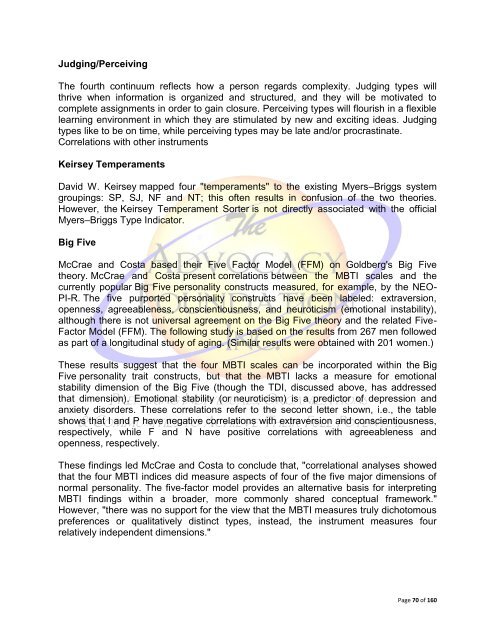The Gift of Introversion
The Gift of Introversion
The Gift of Introversion
You also want an ePaper? Increase the reach of your titles
YUMPU automatically turns print PDFs into web optimized ePapers that Google loves.
Judging/Perceiving<br />
<strong>The</strong> fourth continuum reflects how a person regards complexity. Judging types will<br />
thrive when information is organized and structured, and they will be motivated to<br />
complete assignments in order to gain closure. Perceiving types will flourish in a flexible<br />
learning environment in which they are stimulated by new and exciting ideas. Judging<br />
types like to be on time, while perceiving types may be late and/or procrastinate.<br />
Correlations with other instruments<br />
Keirsey Temperaments<br />
David W. Keirsey mapped four "temperaments" to the existing Myers–Briggs system<br />
groupings: SP, SJ, NF and NT; this <strong>of</strong>ten results in confusion <strong>of</strong> the two theories.<br />
However, the Keirsey Temperament Sorter is not directly associated with the <strong>of</strong>ficial<br />
Myers–Briggs Type Indicator.<br />
Big Five<br />
McCrae and Costa based their Five Factor Model (FFM) on Goldberg's Big Five<br />
theory. McCrae and Costa present correlations between the MBTI scales and the<br />
currently popular Big Five personality constructs measured, for example, by the NEO-<br />
PI-R. <strong>The</strong> five purported personality constructs have been labeled: extraversion,<br />
openness, agreeableness, conscientiousness, and neuroticism (emotional instability),<br />
although there is not universal agreement on the Big Five theory and the related Five-<br />
Factor Model (FFM). <strong>The</strong> following study is based on the results from 267 men followed<br />
as part <strong>of</strong> a longitudinal study <strong>of</strong> aging. (Similar results were obtained with 201 women.)<br />
<strong>The</strong>se results suggest that the four MBTI scales can be incorporated within the Big<br />
Five personality trait constructs, but that the MBTI lacks a measure for emotional<br />
stability dimension <strong>of</strong> the Big Five (though the TDI, discussed above, has addressed<br />
that dimension). Emotional stability (or neuroticism) is a predictor <strong>of</strong> depression and<br />
anxiety disorders. <strong>The</strong>se correlations refer to the second letter shown, i.e., the table<br />
shows that I and P have negative correlations with extraversion and conscientiousness,<br />
respectively, while F and N have positive correlations with agreeableness and<br />
openness, respectively.<br />
<strong>The</strong>se findings led McCrae and Costa to conclude that, "correlational analyses showed<br />
that the four MBTI indices did measure aspects <strong>of</strong> four <strong>of</strong> the five major dimensions <strong>of</strong><br />
normal personality. <strong>The</strong> five-factor model provides an alternative basis for interpreting<br />
MBTI findings within a broader, more commonly shared conceptual framework."<br />
However, "there was no support for the view that the MBTI measures truly dichotomous<br />
preferences or qualitatively distinct types, instead, the instrument measures four<br />
relatively independent dimensions."<br />
Page 70 <strong>of</strong> 160

















